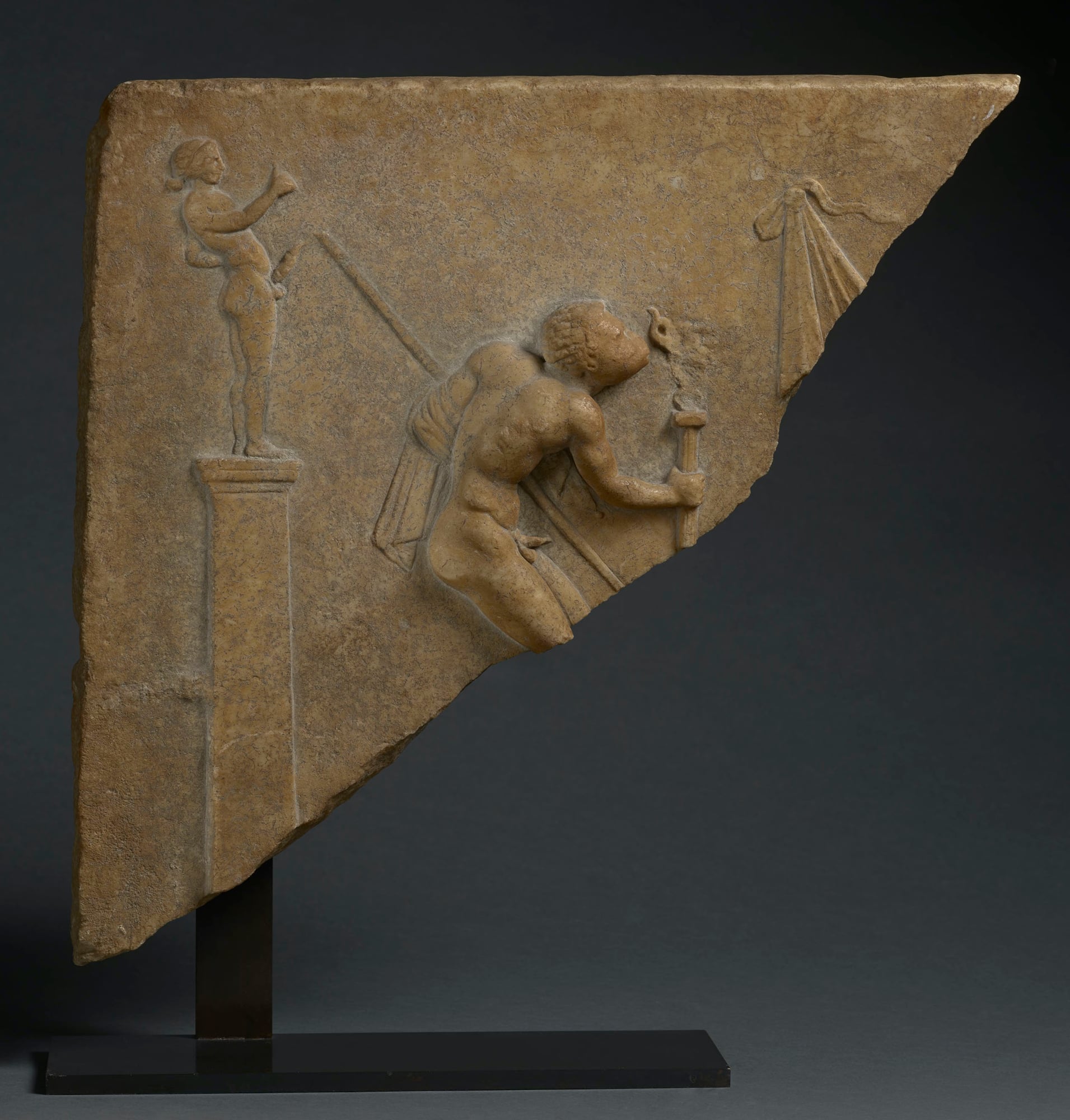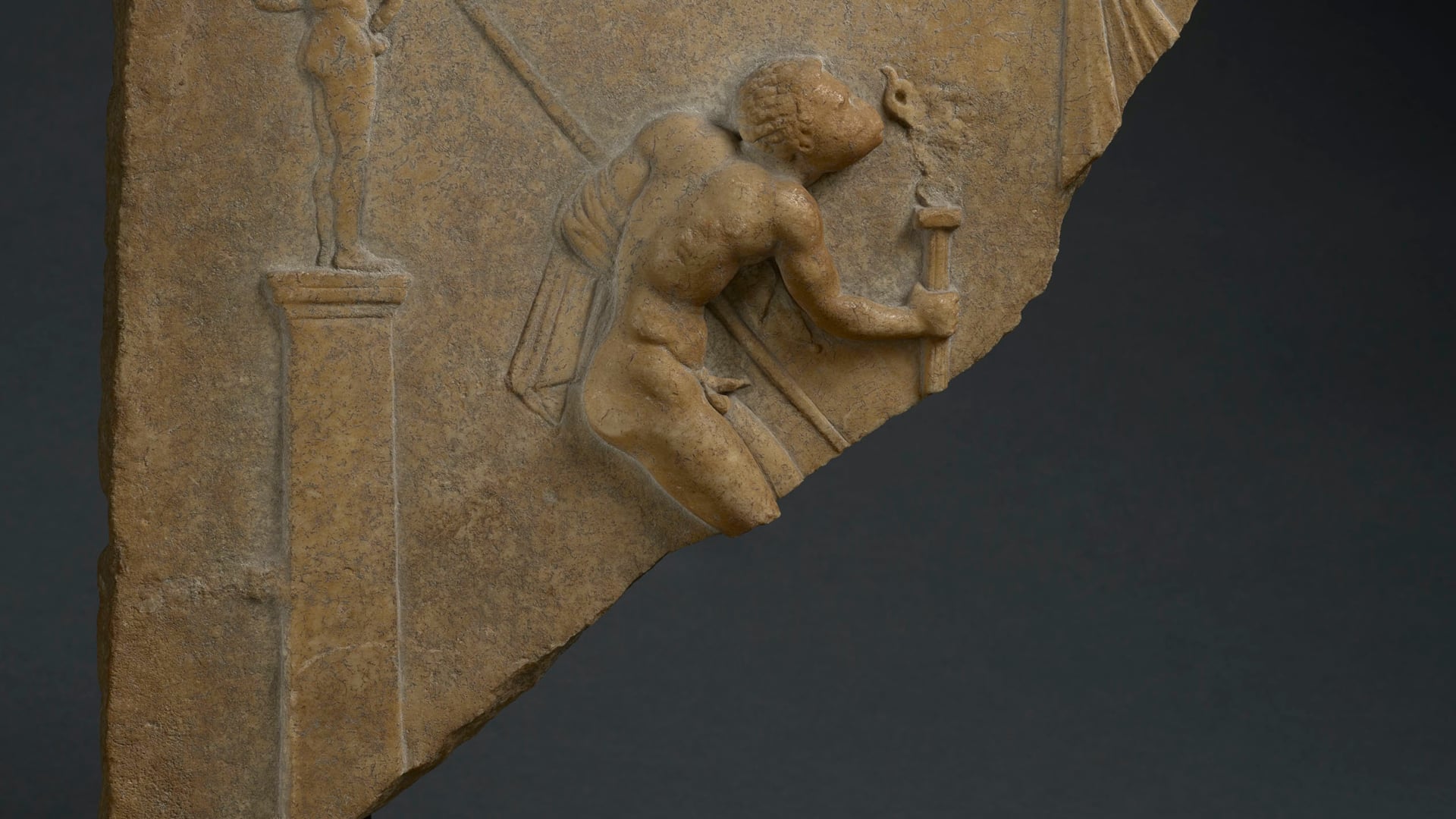

Previously with Kenneth John Hewett (1919-1994), London, from at least 1994
In the Private Collection of Agatha Sadler (1924-2015), London, from at least 1994
Sold at: The Sadler Collection, Sotheby’s, London, 31st October 2002, Lot 29
London art market, acquired from the above sale
Private Collection of Sheikh Saud bin Muhammed Al Thani (1966-2014), acquired from the above 3rd November 2003, to 2021
In the Private Collection of Agatha Sadler (1924-2015), London, from at least 1994
Sold at: The Sadler Collection, Sotheby’s, London, 31st October 2002, Lot 29
London art market, acquired from the above sale
Private Collection of Sheikh Saud bin Muhammed Al Thani (1966-2014), acquired from the above 3rd November 2003, to 2021
The Metropolitan Museum of Art, New York, Loan number L.2011.22.1, 26th July 2011 – 22nd August 2018
Margarete Bieber, The Sculputre of the Hellenistic Age, New York, 1961, p. 155, fig. 651
Heide Froning, Marmor-Schmuckreliefs mit griechischen Mythen im 1 Jh. V. Chr.: Untersuchungen zu Chronologie und Funktion, Mainz am Rhein, 1981, pls. 8, 12 and 20
J.J. Pollitt, Art in the Hellensitic Age, Cambridge University Press, 1986.
D. Bindman and H.L. Gates Jr (Eds.). The Image of the Black in Western Art: Frome the Pharoahs to the the fall of the Roman Empire, vol.I, Harvard U.P., 2010.
F.M. Snowden Jr, “Images and Attitudes: Ancient Views of Nubia and Nubians” in Expedition Magazine, Penn Museum, 1993,vol 35. No.2.
Heide Froning, Marmor-Schmuckreliefs mit griechischen Mythen im 1 Jh. V. Chr.: Untersuchungen zu Chronologie und Funktion, Mainz am Rhein, 1981, pls. 8, 12 and 20
J.J. Pollitt, Art in the Hellensitic Age, Cambridge University Press, 1986.
D. Bindman and H.L. Gates Jr (Eds.). The Image of the Black in Western Art: Frome the Pharoahs to the the fall of the Roman Empire, vol.I, Harvard U.P., 2010.
F.M. Snowden Jr, “Images and Attitudes: Ancient Views of Nubia and Nubians” in Expedition Magazine, Penn Museum, 1993,vol 35. No.2.
This finely carved high relief with the presence of a Nubian figure is a rare and important artefact of the practise of Hellenistic relief carving, and a significant document in highlighting the Greco-Roman world’s knowledge of other peoples and races and, offers a fascinating context to understand such ideas in relation to society today.
The exceptionally well carved Nubian figure is represented nude, with his back to us, turning further away as he leans forward to blow out the flame of a torch held in his right hand. In his left he holds a pole and a cloth. His contorted musculature has been rendered in exacting anatomical detail as have the folds of drapery of the cloth draped on his left arm. To his left a small Priapic figure stands on a column, leaning back with an erect phallus and raised right hand in gesture. Despite being portrayed in miniature his anatomy is realised with equal distinction. To the right of the fragment a ribbon holds up the remainder of a knotted drape, and it appears likely that the whole composition originally represented the Nubian figure approaching a bed or a couch.
This is an important example of a relatively small field of reliefs from the Hellenistic world of which Magarete Bieber has written: “Reliefs of this type were used for the inner decoration of houses, palaces, bath establishments, and other public buildings. The older ones mostly have idyllic scenes of small size; the later ones, probably all made for rich Romans, are mythological scenes of large size. We see here the influence of the nature-loving and luxurious Romans on the Greek artists who worked for them.”
The Nubian, although blowing out a torch, has a contorted body position which could also suggest dance – in keeping with the Greco-Roman notion of the African dancer. The naked figure with large penis, the crouched body position with the protruding buttocks, and the loin cloth on the arm, and the inclusion of a long staff or stick are all attributes associated with a type of ‘stick-dancer’ which recur as a motif in Greco-Roman art and are associated with magic ritual, theatre and pantomime - often lewd and obscene. These figures, clearly reproducing a common prototype, are discussed in an article by Katharine Dunbabin in which she observes that such dancers often have exaggerated or extenuated body parts, dark skin, or sometimes explicitly African features and that there is an association between these ‘stick-dancer’ representations and a type of dancer in antiquity known as gryllos especially common in Egypt. Our Nubian figure is very similar in pose to one such stick dancer found on the extreme right of a relief in the nave of the underground Basilica of Porta Maggiore in Rome in which the figures appear to be in the act of conducting some magic and in which the characters have features and poses with Egyptian associations.
The subject of the scene is of particular interest as depictions of Nubians in Greco-Roman art, whilst not wholly unusual, are relatively rare. Knowledge of Nubia and its people was considerably enlarged during the Ptolemaic period when the Greeks are reported to have travelled to Meroe (an ancient city situated in present day Sudan) and beyond.
The exceptionally well carved Nubian figure is represented nude, with his back to us, turning further away as he leans forward to blow out the flame of a torch held in his right hand. In his left he holds a pole and a cloth. His contorted musculature has been rendered in exacting anatomical detail as have the folds of drapery of the cloth draped on his left arm. To his left a small Priapic figure stands on a column, leaning back with an erect phallus and raised right hand in gesture. Despite being portrayed in miniature his anatomy is realised with equal distinction. To the right of the fragment a ribbon holds up the remainder of a knotted drape, and it appears likely that the whole composition originally represented the Nubian figure approaching a bed or a couch.
This is an important example of a relatively small field of reliefs from the Hellenistic world of which Magarete Bieber has written: “Reliefs of this type were used for the inner decoration of houses, palaces, bath establishments, and other public buildings. The older ones mostly have idyllic scenes of small size; the later ones, probably all made for rich Romans, are mythological scenes of large size. We see here the influence of the nature-loving and luxurious Romans on the Greek artists who worked for them.”
The Nubian, although blowing out a torch, has a contorted body position which could also suggest dance – in keeping with the Greco-Roman notion of the African dancer. The naked figure with large penis, the crouched body position with the protruding buttocks, and the loin cloth on the arm, and the inclusion of a long staff or stick are all attributes associated with a type of ‘stick-dancer’ which recur as a motif in Greco-Roman art and are associated with magic ritual, theatre and pantomime - often lewd and obscene. These figures, clearly reproducing a common prototype, are discussed in an article by Katharine Dunbabin in which she observes that such dancers often have exaggerated or extenuated body parts, dark skin, or sometimes explicitly African features and that there is an association between these ‘stick-dancer’ representations and a type of dancer in antiquity known as gryllos especially common in Egypt. Our Nubian figure is very similar in pose to one such stick dancer found on the extreme right of a relief in the nave of the underground Basilica of Porta Maggiore in Rome in which the figures appear to be in the act of conducting some magic and in which the characters have features and poses with Egyptian associations.
The subject of the scene is of particular interest as depictions of Nubians in Greco-Roman art, whilst not wholly unusual, are relatively rare. Knowledge of Nubia and its people was considerably enlarged during the Ptolemaic period when the Greeks are reported to have travelled to Meroe (an ancient city situated in present day Sudan) and beyond.